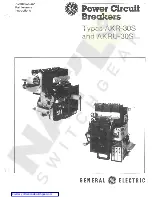
Installations in normal environments
installations in dusty environments* and at low temperatures (1)
( * = measured dust level > 1 mg/m³ )
Servicing procedures
Yearly or after 2000 operations, or after
Six-monthly or after 1000 operations, or
a short circuit has tripped the breaker.
after a short circuit had tripped the breaker.
Servicing intervals
Servicing program
The tables show the servicing program, specifying the timing of the measures and the type of routine servicing procedures, which should
be completed in the order in which they are listed.
It is also advisable to comply with the following rules:
- even circuit breakers that are operated only rarely, or that remain closed or open for lengthy periods of time, need routine servicing;
- in order to establish a suitable time interval for servicing procedures, it is advisable to install a mechanical operations counter (available
on request).
Inspection and general cleaning
Before taking any action:
- open the circuit breaker and make sure that the control springs are not loaded;
- in the event of a withdrawable circuit breaker, take action with the circuit breaker withdrawn from the fixed part;
-
when taking action on circuit breakers with a fixed design, or on the fixed parts of a withdrawable breaker, disconnect
the supply to the power circuit and to the auxiliary circuits, and earth the terminals in a clearly visible manner, both
on the power side and on the load side;
- make the equipment safe in accordance with current laws and standards.
Check the state of cleanliness of the equipment (the circuit-breaking part), taking action to remove any dust or traces of excess
oil or grease with the aid of a clean dry cloth, using spirits or a mild detergent where necessary.
Check for the presence of the labels indicating the technical characteristics of the device.
These labels must be cleaned with a clean dry cloth.
Remove any traces of dust, mould, condensation or rust inside the fixed part of the device.
Check for any signs of factors such as overheating or cracks that might interfere with the efficient insulation of the circuit breaker.
Make sure that the isolating contacts are intact (for withdrawable circuit breakers).
These contacts should be silver in color, with no traces of erosion or smoke.
See figure 1.
'
Make sure there are no foreign objects inside the circuit breaker compartment.
Power connections between the circuit breaker and the switchboard
Remove any dust or dirt depositing on the insulating parts with the aid of a brush and
clean cloths, using a mild detergent if necessary.
Make sure there are no signs of localized overheating on the terminals.
This problem can be identified from any change in the coloring of the parts coming
into contact; the parts in contact are usually silver in color.
Check the tightness of the bolts, using the torque specified in the installation
instructions and catalogues.
Auxiliary circuits
Check the proper connection of the cables and fasteners.
Check the tightness of the circuit breaker fixing screws, using the torque specified in
the installation instructions.
Servicing procedures
Fig. 1
Accessories
Make sure the accessories are firmly
attached to the circuit breaker.
T7M-X1 mechanical control
Lubricate the shafts and the opening
and closing latches with grease type
MOBILGREASE 28 (EXXON MOBIL)
(Fig. 2);
Fig. 2
For the procedures for dismantling and
reinstalling the escutcheon plate, refer
to the circuit breaker installation
instructions, which are also available
on the website http:\\bol.it.abb.com
(1) The servicing operations required for installations in dusty environments apply to the LTT low temperature version of Tmax T7.
Consult ABB SACE for the list of
accessories available for the LTT low
temperature version of Tmax T7.


























